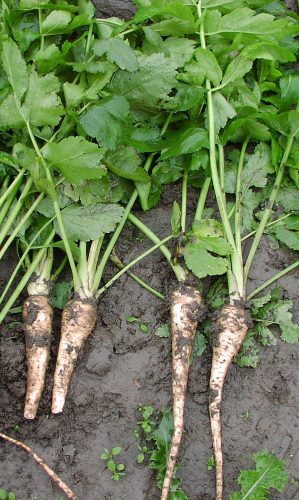Parsnip is easy to grow and need little maintenance.
You are viewing the mobile-adapted version of the page.
The one for tablets, laptop and desktop also provides general information, such as origin and cultivation.
Parsnip (Pastinaca sativa subsp. sativa) belongs to the umbellifer family (Apiaceae or Umbelliferae). Parsnip is native to Eurasia. You can find wild parsnips (Pastinaca sativa) on sunny, nutrient-rich roadsides and water sides. Parsnips can be sown in April/May in the open ground immediately in their final spot. It can take up to a month for the seed to emerge. Not a fast grower; sown in April, means harvest in September. Parsnips like light soils; in heavy clay they struggle and the roots branch out. Sow them in a different spot each year (crop rotation) to outwit soil pests. Among slow-growing parsnips you can grow lettuce, which goes fast. By the time the parsnips are large, the lettuce will have been harvested.
Bugs
Pierced roots, tunnels and rust-colored streaks on the root: carrot fly (Chamaepsila rosae).
Fungi & diseases
Cancerous brown spots on the root, later black: Gangrene (Phoma exigua).
Black or orange spots on the roots and silver-gray spots turning to brown: Parsnip canker (Itersonilia pastinacae).
Other
Parsnip seed germination can be laborious and slow, especially in cold soil, so don’t sow too early and always use fresh seeds.

